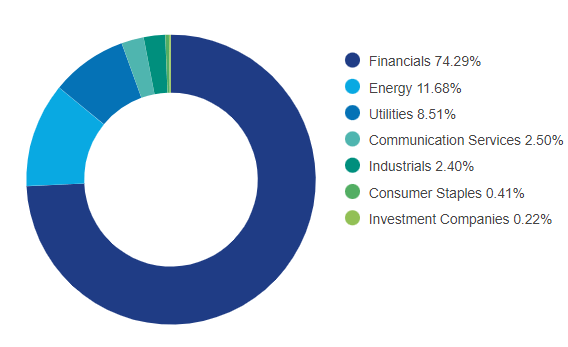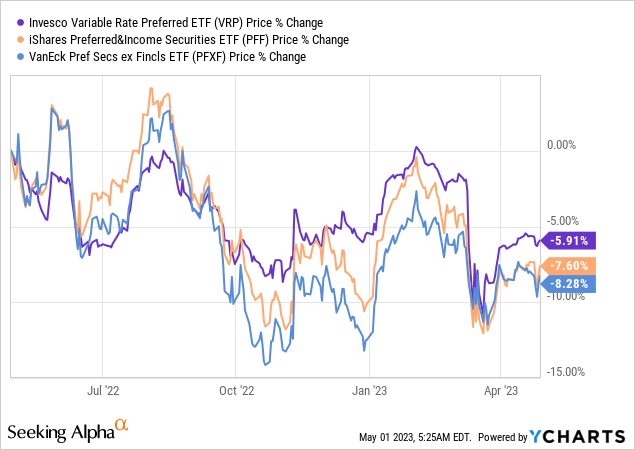Thesis
With yet another bank failure, which has rendered the First Republic (FRC) preferred shares worthless now, we anticipate a structural widening out in bank preferred shares spreads. For the uninformed reader, the FDIC just announced it seized First Republic and it will sell its assets and deposits to JPMorgan (JPM) after taking a $13 billion hit to its deposit insurance fund. That renders the old capital structure for FRC entirely worthless.
Anticipating a structural widening out in spreads, we are going to visit another instrument that provides retail investors with exposure to the preferred equity space, namely the Invesco Variable Rate Preferred ETF (NYSEARCA:VRP):
The Invesco Variable Rate Preferred ETF is based on the ICE Variable Rate Preferred & Hybrid Securities Index (Index). The Fund will generally invest at least 90% of its total assets in floating and variable rate investment grade and below investment grade U.S. dollar denominated preferred stock and hybrid debt publicly issued by corporations in the U.S. domestic market. The Index is designed to track the performance of floating and variable rate investment grade and below investment grade U.S. dollar preferred stock, as well as certain types of hybrid securities that determined by the Index Provider, comparable to preferred stocks, that are issued by corporations in the U.S. market. The Fund does not purchase all of the securities in the Index; instead, the Fund utilizes a “sampling” methodology to seek to achieve its investment objective. The Fund and the Index are rebalanced monthly.
This fund has a wrinkle when compared to other preferred equity funds, namely the focus on variable rate securities. This feature gives the fund exposure to a rising rates environment, which is in turn passed on to retail investors. This composition accounts for the fund’s very low duration profile:

Duration (Fund Fact Sheet)
The fund does not contain any positions in FRC, but will be positively impacted by what we anticipate to be a structurally wider spread environment in the space. Given its composition, VRP ETF offers a fairly low dividend yield when compared to its peers, but also exhibits a low volatility of its returns of only 8% when measured on a 3-year basis.
Analytics
- AUM: $1.6 bil.
- Sharpe Ratio: 0.29 (3Y).
- Std. Deviation: 8 (3Y).
- Yield: 5.66%
- Premium/Discount to NAV: -0.5%
- Z-Stat: n/a
- Leverage Ratio: 0%
- Composition: Fixed Income – Preferred Shares Financials
- Duration: 2 yrs
Holdings
The fund holds an overweight position in financials:

Sectors (Fund Website)
The majority of the portfolio is rated investment grade:

Ratings (Fund Fact Sheet)
We can see that 58% of the holdings fall in the investment grade category, while the rest of the portfolio is sub-investment grade. However, the vast majority of the junk exposure falls in the ‘BB’ bucket, one of the better sub-investment grade sectors.
To note, while the portfolio does not hold any preferred equity from First Republic, it does have a position in another regional bank in the news, namely PacWest Bancorp (PACW):

Holdings (Fund Website)
The allocation is very small though, at only 0.15% of the portfolio.
Performance
The fund is down slightly on a price basis in the past year:

We are benchmarking the ETF against some of its peers here, namely the iShares Preferred and Income Securities ETF (PFF) and the VanEck Preferred Securities ex Financials ETF (PFXF). Due to its low duration, VRP has held up quite well.
Long term, the fund is fairly stable outside recessionary environments:

We have plotted the price performance in the chart above, meaning that the dividend yield is not included. We can observe a nice stable line before the 2022/2023 recession, which translates into investors being able to clip the yield at a stable price point.
Conclusion
VRP is an exchange traded fund focused on variable rate preferred equities. The vehicle has an overweight position in financials, which account for over 74% of the fund. This build explains the fund’s low duration of only 2 years and historically low standard deviation. The fund currently pays only a 5.66% dividend yield, so it does not look extremely attractive at this juncture. We anticipate a structural widening in credit spreads in this space given the latest regional bank failures. This feature coupled with another leg down in the wider equity markets should provide for a nice entry point into VRP. Wait for a 6.15% SEC yield in order to start layering positions into VRP. We are on Hold with respect to this name until then.
Read the full article here












